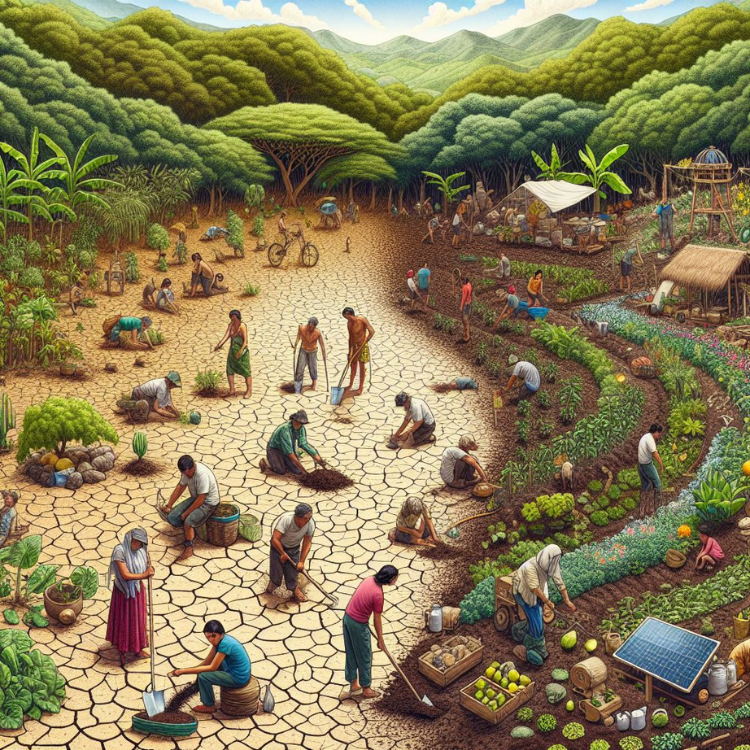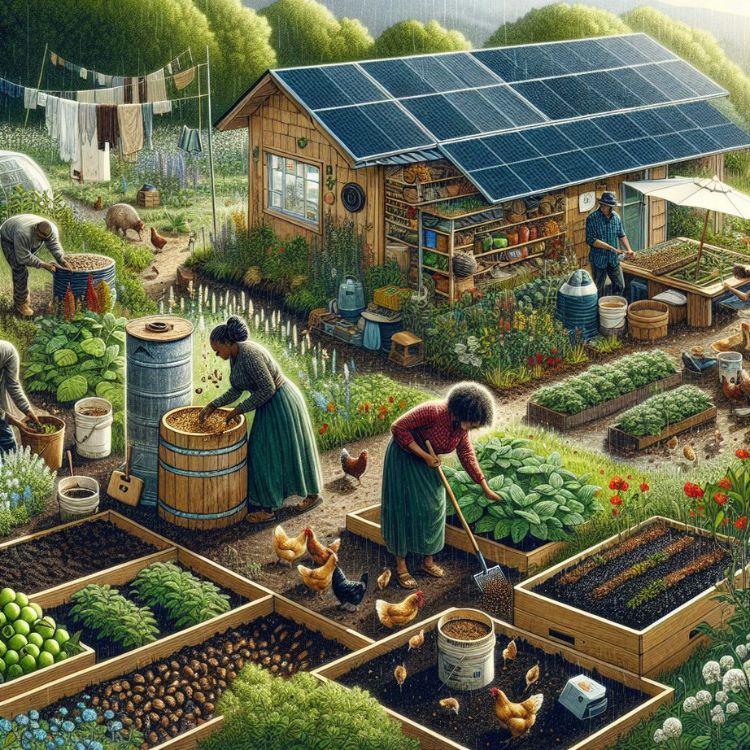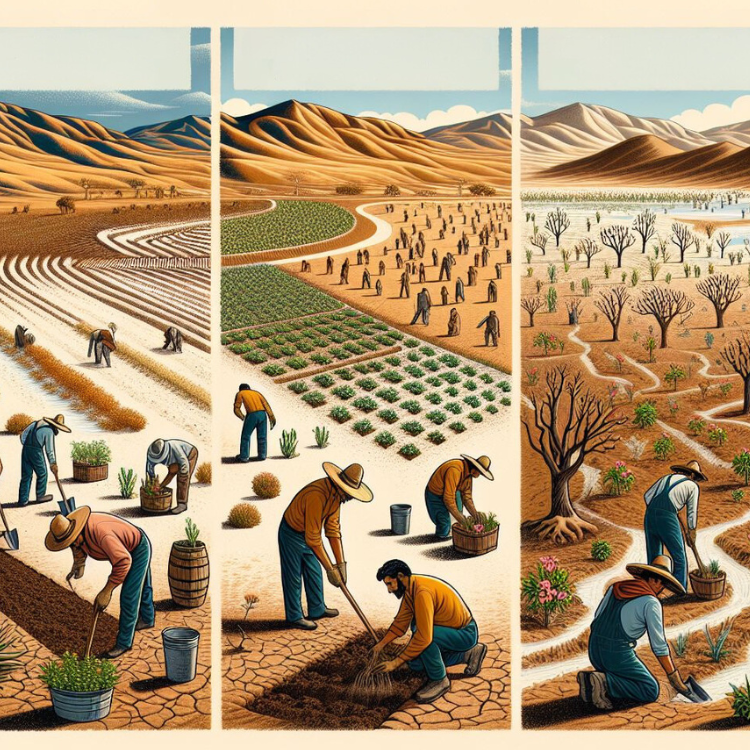
Key Takeaways
- Identify suitable seed varieties for arid conditions to ensure growth.
- Understand the role of soil health and preparation in arid land cultivation.
- Implement water management techniques to maximize efficiency in dry environments.
- Utilize mulching to conserve moisture and regulate soil temperature.
- Employ companion planting to create a self-sustaining ecosystem.
When you’re looking to plant seeds in arid lands, it’s like preparing for a grand adventure. You need the right tools, knowledge, and a bit of courage to brave the elements. Let’s dive into the world of permaculture—a smart and sustainable way to turn dry, barren land into a thriving oasis.
Seeds of Resilience: The Permaculture Approach to Arid Lands
First things first, permaculture is all about working with nature, not against it. It’s a design process that follows nature’s patterns and features to create sustainable and self-sufficient ecosystems. It’s like taking cues from the world’s best gardener—Mother Nature herself!
Defining Permaculture in Dry Environments
In the context of arid lands, permaculture isn’t just about planting seeds. It’s about creating a system that supports plant life despite the tough conditions. This means focusing on soil, water, and plant choices that are in harmony with the local environment.
The Significance of Soil Health in Arid Regions
Soil is the foundation of any garden or farm, and in dry lands, it’s even more crucial. Healthy soil holds water like a sponge and provides nutrients to plants. You want to aim for soil that’s alive with microorganisms and rich in organic matter. This kind of soil is your best ally in an arid climate.
Choosing the Right Seeds for Dryland Cultivation
Now, onto the seeds. Not all seeds are created equal, especially when it comes to dry environments. You’ll want seeds that are drought-resistant and adapted to heat. Think about native plants or varieties that have evolved to thrive in similar conditions. These are the seeds that will stand the best chance of growing strong and healthy.
Practical Permaculture Techniques for Arid Land Planting

With the right mindset and seeds in hand, let’s talk about the techniques that will help these seeds flourish.
Soil Preparation and Enhancement
Before planting, give your soil some love. If it’s compacted, gently break it up without disturbing the soil life too much. Then, add some organic matter—compost, aged manure, or leaf mold. This will not only feed your plants but also improve water retention and soil structure.
Efficient Water Management Strategies
Water is precious in arid regions, so every drop counts. Techniques like rainwater harvesting, drip irrigation, or even the ancient method of olla pots can make a huge difference. These strategies deliver water directly to the roots, reducing waste and ensuring your plants get the hydration they need.
Remember, the key is to start strong and keep things simple. With these initial steps, you’re laying the groundwork for a thriving permaculture system in even the driest of lands. Stay tuned for more detailed strategies and tips on arid land seed planting in the next sections.
Mulching for Moisture Retention and Temperature Control
Mulching is a game-changer in arid land farming. It’s like a protective blanket for your soil, keeping it cool during the day and warm at night. Mulch reduces water evaporation, so your plants stay hydrated longer. Use organic materials like straw, wood chips, or leaves. They’ll break down over time, adding nutrients back into the soil.
Implementing Windbreaks to Protect Delicate Seedlings
Wind can be a seedling’s worst enemy in arid landscapes. It dries out the soil and can damage young plants. Creating windbreaks is like building a shield for your garden. Plant sturdy shrubs, trees, or even construct artificial barriers on the windward side to protect your delicate seedlings.
Example: A community garden in the high desert used a combination of native shrubs and upcycled wooden pallets to create effective windbreaks. This not only protected their plants but also provided habitat for beneficial insects.
Windbreaks can be living or non-living structures that reduce wind speed and its erosive effects. Living windbreaks, such as rows of trees or shrubs, offer the added benefit of enhancing biodiversity and creating wildlife corridors. Non-living windbreaks, like rock walls or fences, are often quicker to implement and can be equally effective.
Most importantly, the placement of windbreaks should be strategic. They should be perpendicular to the prevailing wind direction to maximize their effectiveness. By doing so, you’re not just protecting your plants; you’re also preventing soil erosion and creating microclimates that can lead to more diverse planting opportunities.
Therefore, whether you’re growing a backyard garden or a commercial farm, integrating windbreaks into your design is a wise move for long-term sustainability.
Companion Planting for Nutrient Balance and Pest Reduction
Companion planting is like matchmaking for plants. Some plants get along well and support each other’s growth. For instance, legumes fix nitrogen in the soil, which benefits neighboring plants. Strong-smelling herbs can deter pests, reducing the need for chemical interventions. Here’s a simple guide to get you started:
- Plant marigolds among your veggies to fend off nematodes.
- Grow basil near tomatoes for improved flavor and insect control.
- Sow beans next to corn to utilize space and support nitrogen fixation.
Survival Guide: Ensuring Seed Growth Against the Odds
Let’s face it, planting in arid lands can feel like an uphill battle. But with the right techniques, you can turn the odds in your favor. It’s all about creating the conditions for seeds to not just survive, but thrive.
For starters, always opt for seeds that are pre-adapted to dry conditions. These seeds have a built-in survival kit for the challenges they’ll face. And when planting, give them a deep watering to encourage root growth down into the cooler, moister layers of soil.
Besides that, it’s crucial to monitor your garden closely, especially in the early stages. Keep an eye out for signs of stress in plants, such as wilting or discoloration, and be ready to adjust your strategies accordingly. This might mean providing shade during the hottest part of the day or increasing water frequency during particularly dry spells.
Timing Is Everything: Seasonal Planting Considerations
When it comes to arid land planting, timing is everything. Planting too early or too late can mean the difference between a bountiful harvest and a barren plot. Here’s what you need to know:
- Plant early in the season to take advantage of cooler temperatures and any available moisture.
- Avoid planting during the peak heat to prevent seedlings from being scorched.
- Consider planting in sync with the lunar cycle, as some believe it affects seed germination and growth.
By planting at the optimal time, you give your seeds the best chance at success. And remember, local knowledge is invaluable. Talk to fellow gardeners or reach out to agricultural extension services to get advice tailored to your specific climate and soil conditions.
Therefore, always plan your planting calendar with the local weather patterns in mind. It’s not just about the right month; it’s about understanding the rhythms of your environment and responding to them.
Microclimate Creation to Buffer Extreme Conditions
For example, a gardener in New Mexico used old tires filled with soil to plant potatoes. The black rubber absorbed heat during the day and released it at night, creating a microclimate that kept the plants warm during unexpected cold snaps.
Creating microclimates is like tailoring the weather to suit your plants. Use rocks, water features, or even different plant heights to create pockets of humidity or shade. These small adjustments can make a significant impact on the survival and productivity of your garden.
Another technique is to use terracing on slopes, which can reduce wind exposure and capture water more effectively. By sculpting the land, you’re not just planting seeds; you’re engineering a landscape that supports life.
Most importantly, these microclimates can be the difference between a plant withering or flourishing. They’re especially valuable in arid lands, where the environment can be harsh and unforgiving.
Adapting to Water Scarcity with Drought-Tolerant Varieties
Choosing the right plant varieties is crucial in arid land farming. Opt for drought-tolerant species that are naturally equipped to handle low-water conditions. These plants often have deep root systems, waxy leaves, or other adaptations that allow them to conserve water.
Here’s what you should consider:
- Research local native plants—they’re already adapted to your region’s climate.
- Look for varieties that are labeled as drought-tolerant or suitable for xeriscaping.
- Experiment with heirloom seeds from dry regions of the world, as they often have traits that help them thrive in water-scarce environments.
By choosing the right plants, you’re setting up your garden for success from the very beginning. And when you pair these varieties with the other techniques we’ve discussed, you’re well on your way to a lush, productive garden, even in the driest of landscapes.
Permaculture Mindset: Understanding Nature’s Signals

Permaculture is more than a set of techniques; it’s a mindset. It’s about being attuned to nature’s signals and responding to them. It’s about observing the patterns, understanding the flows of water and wind, and respecting the cycles of life and decay.
When you adopt this mindset, you become a steward of the land. You start to see the connections between all living things and how your actions can support or disrupt these relationships. You learn to work with nature, not against it, and in doing so, create a more resilient and sustainable ecosystem.
And remember, permaculture is a journey, not a destination. There will be successes and failures, but each experience is a lesson that brings you closer to harmony with the land. Embrace the process, and let nature be your guide.
Reading the Landscape: Observing and Adapting
As eco-conscious growers, observing the land before planting is crucial. The land tells a story, revealing clues about where water flows, where it collects, and which areas receive more sun or shade. By reading these signs, you can place your seeds where they have the best chance of thriving. It’s about adapting to the environment rather than forcing it to adapt to us.
Patience and Observation: Learning from Failures
Permaculture is a practice of patience and observation. Sometimes, despite our best efforts, a crop might fail. This isn’t a defeat; it’s a learning opportunity. By understanding what went wrong, whether it’s the timing of planting, the choice of seed, or water management, we grow as gardeners. Each failure teaches us more about our unique landscape and how to work within it.
FAQs: Arid Land Seed Planting and Permaculture Techniques
Now, let’s address some frequently asked questions that might be on your mind as you embark on your arid land planting journey.
What Are Some Common Misconceptions About Seed Planting in Arid Lands?
One common misconception is that arid lands are infertile and incapable of supporting plant life. This is simply not true. With the right techniques, even the driest soils can become productive. Another misconception is that arid land farming requires a lot of water. In reality, it’s about using water wisely and efficiently, not in abundance.
How Do Permaculture Techniques Address Salinity in Soil?
Salinity can be a big challenge in arid lands. Permaculture addresses this by improving soil organic matter, which increases the soil’s ability to flush out salts. Additionally, planting salt-tolerant species and using mulches can help prevent salt accumulation on the soil surface.
Can Permaculture Techniques Help with Erosion in Arid Lands?
Absolutely. Techniques like mulching, creating windbreaks, and using ground cover plants can significantly reduce soil erosion. Contour planting and swales also help by slowing down water runoff and allowing it to percolate into the soil rather than washing soil away.
What Are Some Native Plants Suitable for Arid Land Permaculture?
Native plants are your best bet for arid land permaculture because they’re already adapted to the local climate. Some examples include mesquite trees, which can bring up deep water with their long roots, or prickly pear cacti, which are not only drought-tolerant but also provide edible fruit.
How Frequently Should Seeds Be Watered in a Dryland Setting?
Watering frequency in drylands depends on several factors, including soil type, weather, and the stage of plant growth. A general rule is to water deeply but infrequently, encouraging roots to grow deeper in search of moisture. Always check the soil moisture before watering to avoid over-irrigation.
In conclusion, arid land seed planting using permaculture techniques is about working with the environment to create a self-sustaining ecosystem. It’s about selecting the right seeds, preparing the soil, managing water wisely, and being patient and observant. By following these principles, you can cultivate a thriving garden that respects and enhances the natural landscape. Remember, with the right approach, even the most challenging environments can yield an abundance of life.
If you’re ready to start your arid land planting adventure, consider exploring a range of heirloom seeds specifically curated for dry environments at Survival Essentials. With the right seeds and knowledge, you’ll be well on your way to creating a resilient and vibrant garden that can withstand the tests of nature.
Understanding the essentials of permaculture and seed planting in arid lands can be crucial for your survival garden. Arid climates pose unique challenges, but with the right knowledge and techniques, you can grow a thriving garden that conserves water and adapts to the local environment. This guide provides practical tips for selecting drought-resistant plants, conserving water, and creating a sustainable garden ecosystem even in the harshest conditions.






